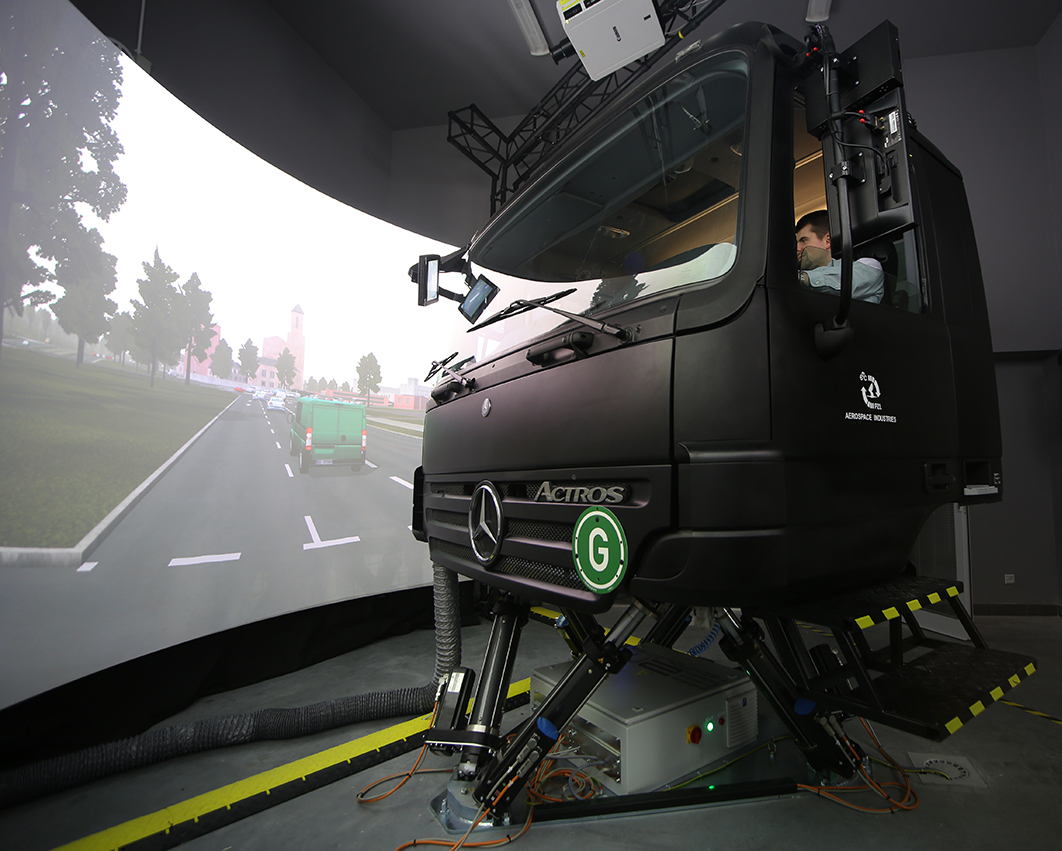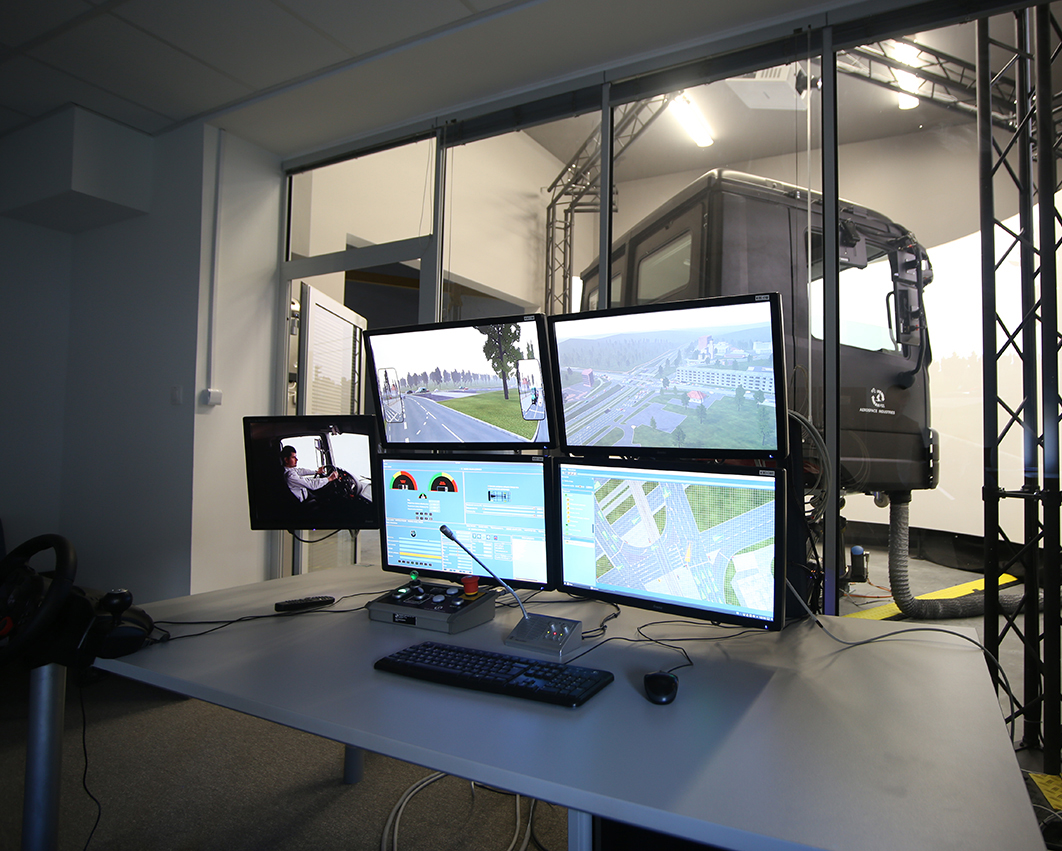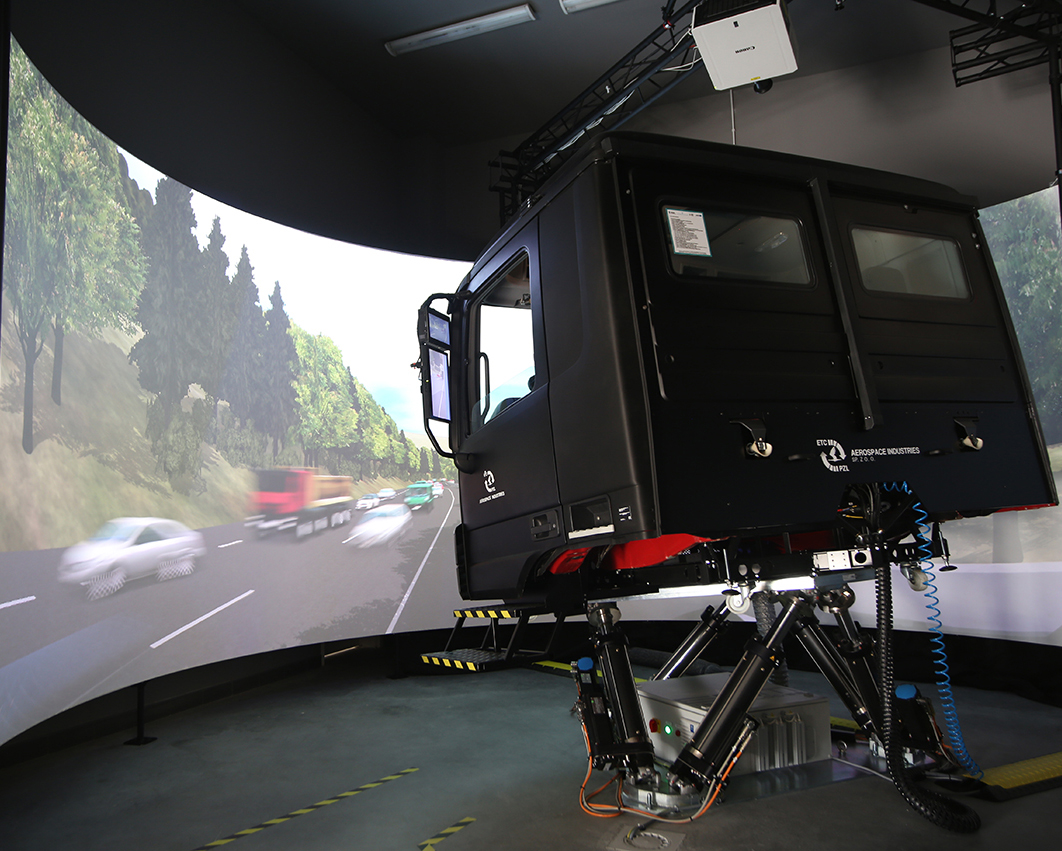
The truck simulator is a stationary device, equipped with a six-degree motion system and reproducing the functioning of the truck on the basis of the Mercedes Benz Actros cab. It is intended for conducting research and trainings of drivers in simulated traffic conditions.
The simulator meets the requirements of the Regulation of the Minister of Infrastructure of April 8, 2011 on the device for simulating driving in special conditions (Journal of Laws of 2011, No. 81, item 444).
The simulator has been modernized under the project entitled “Multidisciplinary Research Center of Cardinal Stefan Wyszyński University in Warsaw”, financed by the European Regional Development Fund under the Regional Operational Program of the Masovian Voivodeship for 2014-2020 (Contract No. RPMA.01.01.00-14-8496/17-00).
Main characteristics:
- Mercedes Benz Actros truck cab
- Cabin motion system with six degrees of freedom (6 DoF)
- Presentation layout on a cylindrical screen with a horizontal field of view of 180o
- Three laser projectors with WUXGA resolution
- Automatic geometric calibration system
- Acoustic background simulation system
- Instructor (operator) position
- Biomedical and environmental parameters monitoring system
Capabilities:
- Simulation of driving during the day and at night, in summer and winter, in changing weather conditions, e.g. during rain, snow, fog, gusts of wind
- Simulation of different types of terrain, e.g. city, highway, mountainous terrain
- Simulation of difficult environmental conditions, e.g. desert areas, training grounds
- Simulation of effects on the roadway, e.g. irregularities, holes, puddles, belt icing, oil stains
- Simulation of vehicles involved in joint traffic with the vehicle of the trainee/examined driver, including passenger vehicles, trucks, privileged vehicles, trams, trains
- Simulation of passers-by, including e.g. pedestrian intrusion into the roadway, an injured person calling for help, a drunk person near the roadway
- Simulation of crowds of people, e.g. manifesting, aggressive
- Simulation of animals, e.g. a herd of wild boars on the road, a dog entering the roadway
- Simulation of collisions with other traffic participants
- Simulation of collisions with static objects, e.g. buildings, trees, stops, lanterns
- Simulation of different road situations, including emergencies, e.g. tanker accident, load falling from a vehicle, police check, bough lying on the roadway or falling from a nearby tree, fire or flooding of an area, police officer directing traffic at an intersection
- Simulation of exercises on the maneuvering area, including a rectangular sliding plate with an optional jerk, 120 or 360 degree sliding bow, slalom, bow riding
- Simulation of a failure of the steered vehicle, e.g. wheel lock, engine seizure, gear lock, exterior light failure, windscreen breakage, explosion, fire, leakage, mirror failure
- Generation of sounds reproducing those heard in a real vehicle, e.g. engine and propulsion system noises, acoustic effects of driving on rough roads, sounds of other vehicles in motion, alarm
- Common simulation in a uniform virtual simulation environment using several simulators
- Creating exercise scenarios
- Monitoring drivers' electrical activity of heart (ECG) and muscles (EMG), respiration, skin bioimpedance, critical frequency of the light stimulus flickering/ confluence
- Measurement of the steering wheel squeeze
- Measurement of accelerations while driving (on three axes)
Application:
- Training of driving skills in various terrain and weather conditions, including special ones
- Training of driver’s behavior in urgent and dangerous situations on the road
- Training in difficult environmental conditions, e.g. in the desert, on the training ground
- Practicing operator skills on the maneuvering area
- Assessment of the psychophysiological load of the driver while driving
- Investigating the psychophysiological reactions of the driver in response to events that may threaten road safety
- Scientific research on the impact of various subjective and environmental factors on safe driving
Manufacturer: ETC-PZL Aerospace Industries Sp. z o.o.
References: Baran et al. Technical properties and research capabilities of the truck simulator owned by the Military Institute of Aviation Medicine – a new perspective in research on truck drivers. Pol J Aviat Med Bioeng Psychol 2019; 25(3):26-31.
![]()
![]()
| Contact: |
M.Sc. Marcin Piotrowski PhD Paulina Baran |




